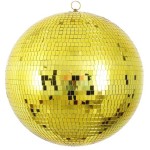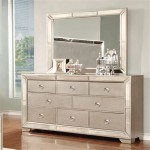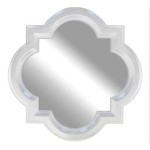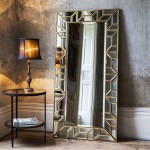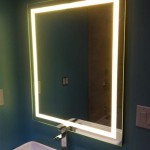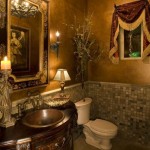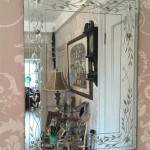Art Deco Stained Glass Mirrors
Art Deco stained glass mirrors represent a fascinating intersection of two prominent design movements of the early 20th century. The geometric precision and streamlined elegance of Art Deco, coupled with the vibrant colors and intricate craftsmanship of stained glass, resulted in exquisite decorative pieces that remain highly sought after today. These mirrors served not only as functional objects but also as striking works of art, reflecting the era's fascination with modernity and luxury.
Geometric Patterns and Designs
A defining characteristic of Art Deco stained glass mirrors is their emphasis on geometric patterns. Clean lines, sharp angles, and symmetrical compositions are frequently observed. Popular motifs include stylized floral patterns, sunbursts, chevrons, and stepped forms, all rendered in bold, abstract interpretations. These geometric designs contribute to the overall sleek and sophisticated aesthetic of the mirrors.
Rich Color Palettes
The use of vibrant and contrasting colors is another key feature. Art Deco stained glass mirrors often incorporate a rich palette of jewel tones, including deep blues, emerald greens, ruby reds, amber yellows, and amethyst purples. These colors are frequently juxtaposed against a backdrop of clear or frosted glass, creating a dramatic visual effect and enhancing the luminosity of the piece.
Use of High-Quality Materials
Art Deco stained glass mirrors were typically crafted using high-quality materials, reflecting the era's emphasis on craftsmanship and durability. The glass itself was often opalescent or iridescent, adding depth and shimmer to the overall design. Lead came was used to join the individual pieces of glass, providing structural integrity and adding a decorative element. The frames were often made of polished metals, such as chrome or nickel, or exotic woods, further enhancing the luxurious feel.
Influence of Cubism and Fauvism
The stylistic influences of other art movements are evident in Art Deco stained glass mirrors. Cubism, with its fragmented forms and multiple perspectives, and Fauvism, known for its bold use of color, both contributed to the distinctive aesthetic of these mirrors. The geometric abstraction of Cubism is reflected in the angular patterns, while the vibrant color palettes of Fauvism are echoed in the rich jewel tones employed.
Variety of Shapes and Sizes
Art Deco stained glass mirrors were produced in a wide range of shapes and sizes, catering to various decorative needs. Small, rectangular mirrors were commonly used in powder rooms and hallways, while larger, more elaborate mirrors served as focal points in living rooms and dining areas. Circular, oval, and even octagonal shapes were also employed, reflecting the Art Deco penchant for geometric experimentation.
Restoration and Conservation
Given their age and delicate nature, Art Deco stained glass mirrors often require restoration and conservation. This intricate process involves carefully cleaning the glass, repairing any cracks or damage to the lead came, and stabilizing the frame. Experienced conservators strive to preserve the original integrity of the piece while ensuring its longevity for future generations.
Contemporary Interpretations
The enduring appeal of Art Deco stained glass mirrors has led to contemporary interpretations of this classic style. Modern artisans continue to draw inspiration from the geometric patterns, rich colors, and luxurious materials of the Art Deco era, creating new pieces that capture the essence of the original while incorporating contemporary design elements. These modern interpretations demonstrate the timeless elegance and versatility of this unique art form.
Integration into Interior Design
Art Deco stained glass mirrors can be seamlessly integrated into a variety of interior design schemes. They work particularly well in Art Deco-inspired spaces, complementing the period furniture and décor. However, their versatility also allows them to enhance more contemporary settings, adding a touch of glamour and sophistication to minimalist or eclectic interiors.
Collecting and Valuation
Collecting Art Deco stained glass mirrors has become a popular pursuit among antique enthusiasts and design aficionados. The value of these mirrors is determined by several factors, including the quality of the craftsmanship, the rarity of the design, the condition of the piece, and the provenance. Authentic Art Deco mirrors, particularly those by renowned designers or manufacturers, can command significant prices in the antiques market.

Stained Glass Mirror Art Deco The Edge

Hand Made Marine Blue Art Deco Stained Glass Mirror

Art Deco Wall Mirror Elegant Stained Glass Primi Mosaics
Art Deco Fan Stained Glass Wall Mirror Autumn Red

Stained Glass Deco Circle Mirror 100cm 39in Lawson Glassworks

Peaches Art Deco Style Leadlight Stained Glass Mirror Felt

Art Deco Fans Mirror Stained Glass Light Panels Designs

Plum Art Deco Style Leadlight Stained Glass Mirror Felt

Commercial Original Coloured Stained Glass Art From 300 Bespoke Mirrors Deco Custom Made

Peacock Original Coloured Stained Glass Art Bespoke Mirrors Deco Custom Made

